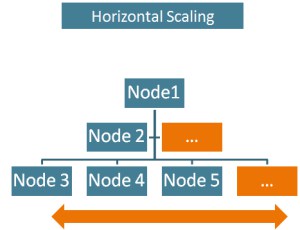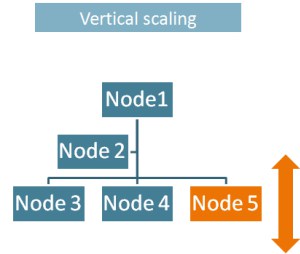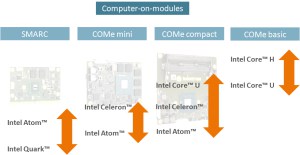Come scale with us! This motto has driven a webinar which I held together with Intel in mid- September. Within the webinar we explained how and why it makes sense to implement scalable solutions, what the benefits of using Kontron’s scalable product portfolio are and how costumers can seamlessly deploy these solutions themselves. Within this blog I will give you an overview of the issue by summarizing some of our most important content.
According to Wikipedia, Scalability is the ability of a system, network, or process to handle a growing amount of work in a capable manner or its ability to be enlarged to accommodate that growth. There are two different ways to do so: vertical and horizontal scaling. Vertical scaling means, that one node enlarges its capabilities, while horizontal scaling described the possibility to increase the amount of nodes in a network.

Scalablity: Horizontal Scaling

Scalability: Vertical Scaling
But what does this mean for the electronic design of a product? Basically it means that it should be easy to get more, less or just a different processor performance, graphical performance, RAM, price, power consumption, IO or lifetime. In these days, where the IoT is spreading without foreseeable end, the prerequisites for an intelligent device – like an ultrasonic scanner, park ticket cashing system or an elevator controller – are changing permanently, so the device needs to be frequently adapted to different characteristics. And even a lifetime extension is possible by just migrating from one product to a new generation product (7 -> 14 years). It is a measure of scalability how easy these changes can be realized.
More scalability means less cost for changes
And scalability in Electronic (HW) design also means that it should be easy to extend a product portfolio by creating new products with different characteristics. For instance, there is a certain product portfolio of one customer and he plans to add a new variant to bring that into the market. This is what you call horizontal scaling. Typical here are low end, mid and high end variants which all address a different target group. So scalability really is the measure of easiness to adapt to different needs. More scalability means less cost for changes, because already existing parts can be reused.
Many of our customers face the questions where it does make sense to scale. So let me give two practical examples that show the great advantages of scalability in customer projects. One is ourot-in PC according to OPS standard defined by Intel and NEC which was developed by our partner company Aaronn. The PC includes high-performance CPUs for Digital Signature Applications and a standardized OPS connector for easy plug-in. There are various configurations available including different CPUs: Intel® Core™ i3/i5/i7/Celeron. Due to our COM approach it is easy to migrate to latest CPU platforms. The PC also supports all common Windows embedded and Linux OS (also BSPs available) and offers additional DVI-I output for a second display, expressCard Slot for WLAN modules and an integrated SSD storage.
Within another application the goal has been to extend the longevity for an inflight entertainment server. The customer created an Inflight Entertainment Server in 2008 which was based on a Carrier Board and COMe mini (Atom based) module. The main interfaces are Ethernet and PCIe x1. The original module (COMe-mSP1) has gone EOL (“End-of-life”) last year but we updated the platform with a new module (COMe-mBTi10) including certification. There were just some small carrier board changes necessary, because of a pin-out change in COM Express. Of course there are also driver and BSP updates available for the OS. Finally, this measure leads to a lifetime of 15 years for IFE.
23.040 configurations possible
The easiest way to scale is within a product. If you take a look on any of our standard boards, which are motherboards or Computer-on-Modules, there are different variants available. For example in mITX-E38, our Baytrail based motherboard we have 3 different variants (SKUs) with a quad core, a dual core and a single core processor available. On our COMe mini Module COMe-mBT10 we have in addition to different CPUs also different options for RAM, flash and more. This variety is made possible by 9 different CPUs, 8 x RAM, 10 x Flash, 5 different options like a TPM (“Trusted Platform Module”). All in all, there are 23.040 configurations possible. Out of this variety we have created 12 SKUs with a standard configuration but any possible configuration can be created for our customer on a project base.
If you scale within one product, there is absolutely no change in mechanics, functions (depending on the options), pin-out and software. But it’s also possible to scale within a product line, in our case, just by a different module of the same form factor. This requires adaption to the software because different interface drivers might be necessary, but nevertheless it’s quite easy to get different ranges to scale. Within our COMe it’s also an option to scale from COMe mini to COMe basic if you make some mechanical precautions. Our COMe’s have a defined interface via standardized connector, the same mechanical footprint and a defined thermal interface (= heat spreader). The modules are mounted on a carrier board (or “baseboard”) which routes the interfaces out to standard peripheral connectors. One carrier board can use different modules.

Scalability of our Computer-on-modules
To save costs and extend the lifetime of a product through scalability, the intention so scale must already be a part of the design process. The decisions one takes during the design and early development phase will largely dictate the scalability of an application.
If you want to know more, you can also join our Carrier Board Design Trainings. But first, tell us about your experiences with scalable solutions and leave a comment!

{{comment.comment}}